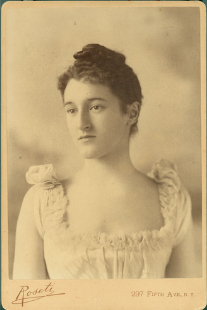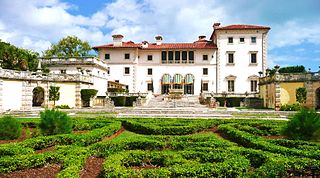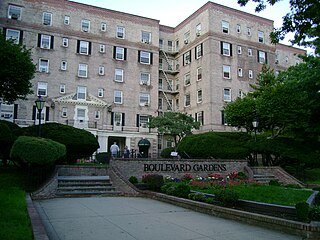Related Research Articles

Frederick Law Olmsted was an American landscape architect, journalist, social critic, and public administrator. He is popularly considered to be the father of American landscape architecture. Olmsted was famous for co-designing many well-known urban parks with his senior partner Calvert Vaux. One of Olmstead's early works included designing the Walnut Hill Park in New Britain, Connecticut. His later efforts included Central Park and Prospect Park in New York City and Cadwalader Park in Trenton. He headed the pre-eminent landscape architecture and planning consultancy of late nineteenth-century America, which was carried on and expanded by his sons, Frederick Jr and John C, under the name Olmsted Brothers.

Beatrix Cadwalader Farrand was a landscape gardener and landscape architect in the United States. Her career included commissions to design about 110 gardens for private residences, estates and country homes, public parks, botanic gardens, college campuses, and the White House. Only a few of her major works survive: Dumbarton Oaks in Washington, D.C., the Abby Aldrich Rockefeller Garden on Mount Desert, Maine, the restored Farm House Garden in Bar Harbor, the Peggy Rockefeller Rose Garden at the New York Botanical Garden, and elements of the campuses of Princeton, Yale, and Occidental.

Landscape architecture is the design of outdoor areas, landmarks, and structures to achieve environmental, social-behavioural, or aesthetic outcomes. It involves the systematic design and general engineering of various structures for construction and human use, investigation of existing social, ecological, and soil conditions and processes in the landscape, and the design of other interventions that will produce desired outcomes. The scope of the profession is broad and can be subdivided into several sub-categories including professional or licensed landscape architects who are regulated by governmental agencies and posses the expertise to design a wide range of structures and landforms for human use; landscape design which is not a licensed profession; site planning; stormwater management; erosion control; environmental restoration; parks, recreation and urban planning; visual resource management; green infrastructure planning and provision; and private estate and residence landscape master planning and design; all at varying scales of design, planning and management. A practitioner in the profession of landscape architecture may be called a landscape architect, however in jurisdictions where professional licenses are required it is often only those who posses a landscape architect license who can be called a landscape architect.

Humphry Repton was the last great English landscape designer of the eighteenth century, often regarded as the successor to Capability Brown; he also sowed the seeds of the more intricate and eclectic styles of the 19th century. His first name is often incorrectly rendered "Humphrey". In 2018, the bicentenary of Repton's death, several groups held events throughout the United Kingdom to celebrate his work.

In architecture, a folly is a building constructed primarily for decoration, but suggesting through its appearance some other purpose, or of such extravagant appearance that it transcends the range of garden ornaments usually associated with the class of buildings to which it belongs.

A landscape architect is a person who is educated in the field of landscape architecture. The practice of landscape architecture includes: site analysis, site inventory, site planning, land planning, planting design, grading, storm water management, sustainable design, construction specification and ensuring that all plans meet the current building codes and local and federal ordinances. The title landscape architect was first used by Frederick Law Olmsted, the designer of New York City's Central Park.

A landscape is the visible features of an area of land, its landforms, and how they integrate with natural or man-made features. A landscape includes the physical elements of geophysically defined landforms such as (ice-capped) mountains, hills, water bodies such as rivers, lakes, ponds and the sea, living elements of land cover including indigenous vegetation, human elements including different forms of land use, buildings, and structures, and transitory elements such as lighting and weather conditions. Combining both their physical origins and the cultural overlay of human presence, often created over millennia, landscapes reflect a living synthesis of people and place that is vital to local and national identity.

Brooklyn Botanic Garden (BBG) is a botanical garden in the borough of Brooklyn, New York City. It was founded in 1910 and is located in Mount Prospect Park in central Brooklyn, adjacent to Prospect Park and the Brooklyn Museum. The 52-acre (21 ha) garden holds over 14,000 taxa of plants and has nearly a million visitors each year. It includes a number of specialty "gardens within the Garden", plant collections, the Steinhardt Conservatory that houses the C. V. Starr Bonsai Museum, three climate-themed plant pavilions, a white cast-iron-and-glass aquatic plant house, and an art gallery.

The New York Botanical Garden (NYBG) is a botanical garden located at Bronx Park in the Bronx, New York City. Established in 1891, it is located on a 250-acre (100 ha) site that contains a landscape with over one million living plants; the Enid A. Haupt Conservatory, a greenhouse containing several habitats; and the LuEsther T. Mertz Library, which contains one of the world's largest collections of botany-related texts. As of 2016, over a million people visit the New York Botanical Garden annually.

The Vizcaya Museum and Gardens, previously known as Villa Vizcaya, is the former villa and estate of businessman James Deering, of the Deering McCormick-International Harvester fortune, on Biscayne Bay in the present day Coconut Grove neighborhood of Miami, Florida. The early 20th century Vizcaya estate also includes: extensive Italian Renaissance gardens; native woodland landscape; and a historic village outbuildings compound. The landscape and architecture were influenced by Veneto and Tuscan Italian Renaissance models and designed in the Mediterranean Revival architecture style, with Baroque elements. F. Burrall Hoffman was the architect, Paul Chalfin was the design director, and Diego Suarez was the landscape architect.

Roberto Burle Marx was a Brazilian landscape architect whose designs of parks and gardens made him world-famous. He is accredited with having introduced modernist landscape architecture to Brazil. He was known as a modern nature artist and a public urban space designer. His work had a great influence on tropical garden design in the 20th century. Water gardens were a popular theme in his work. He was deftly able to transfer traditional artistic expressions such as graphic design, tapestry and folk art into his landscape designs. He also designed fabrics, jewellery and stage sets.

Laurie Olin is an American landscape architect. He has worked on landscape design projects at diverse scales, from private residential gardens to public parks and corporate/museum campus plans.
Michael Robert Van Valkenburgh is an American landscape architect and educator. He has worked on a wide variety of projects in the United States, Canada, Korea, and France, including public parks, college campuses, sculpture gardens, city courtyards, corporate landscapes, private gardens, and urban master plans.

Ellen Biddle Shipman was an American landscape architect known for her formal gardens and lush planting style. Along with Beatrix Farrand and Marian Cruger Coffin, she dictated the style of the time and strongly influenced landscape design as a member of the first generation to break into the largely male occupation.
Elizabeth Barlow Rogers is a landscape designer, landscape preservationist and writer. Her most notable project is the revitalization of Central Park in New York City. After serving as Central Park administrator, Rogers became the first president of the Central Park Conservancy, a private not-for-profit corporation that she helped found in 1980 to bring citizen support to the restoration and renewed management of Central Park.

The New York Chinese Scholar's Garden is part of the Staten Island Botanical Garden, located in the Snug Harbor Cultural Center. Materials were shipped to Staten Island in the spring of 1998, when a team of 40 Chinese artists and artisans from Suzhou constructed the garden. It opened in June of 1999.

The Boulevard Gardens Apartments is a 960-unit apartment complex at 54th Street and 31st Avenue in Woodside, Queens, New York City. It opened in June 1935, during the Great Depression. They were designed by architect Theodore H. Englehardt for the Cord Meyer Development Corporation; the design was based on an apartment complex Elgelhardt designed in Forest Hills.

Ignatz Anton Pilát (1820–1870) was an Austrian-born gardener who migrated to the United States to work on the design and planting of New York City's Central Park.
Jane Silverstein Ries (1909–2005), also known professionally as Julia Jane Silverstein, was an American landscape architect who was the first woman licensed in Colorado as a professional landscape architect. For her landscape work as well as her efforts to preserve and restore historical sites, she was inducted into the Colorado Women's Hall of Fame and a foundation was established in her name that awards scholarships in her field and supports an annual lecture series.
Nelson Byrd Woltz Landscape Architects (NBW) is an American landscape architecture firm based in New York, Charlottesville, and Houston, founded in 1985 by Warren Byrd and Susan Nelson, and led by Thomas Woltz.